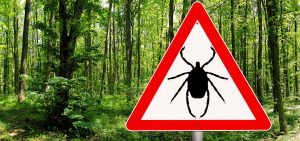Changing climate brings more ticks and related diseases to southeast Ohio
By: Gabriel Scotto
Posted on:
ATHENS, Ohio (WOUB) — When discussing the effects of climate change, ticks may not be the first thing that comes to mind for most people. However, these tiny arachnids are symptomatic of a far greater threat.

“As a result of climate change, we’re seeing increased survivability of ticks, especially coupled with increased humidity,” said Ed Brown, agriculture and natural resources educator with the Ohio State University extension office in Athens County. “We’re seeing not only an uptick in the number of ticks, but in the number of species as well.”
The first deer ticks were spotted in Coshocton County in 2010. A decade later, the Lone Star tick, the Gulf Coast tick and the Asian longhorned tick have all established colonies throughout Ohio. These ticks hitch rides on migratory birds and other animals from the South and West, whose migration paths have been altered because of climate change.
The largest increase in the tick population in Ohio has been in the south. This has resulted in a greater number of cases of Lyme disease and other tick-borne illnesses such as Rocky Mountain spotted fever, anaplasmosis and Powassan virus.
“Coshocton, Tuscarawas, Harrison, Jefferson and Belmont are the counties where we’re seeing the most Lyme disease cases,” said Tim McDermott, agriculture and natural resources educator with the Ohio State University extension office in Franklin County.
In addition to an increase in the number of ticks and tick species, the number of ticks carrying disease has increased substantially. “In some counties, the percentage of ticks carrying disease is between 40 and 60 percent and I’ve seen higher percentages in certain hotspots,” McDermott said.
While southern Ohio has been hardest hit, urban counties such as Cuyahoga County have also witnessed their tick populations explode in recent years. “We have ticks pretty much everywhere. They’re all over Ohio,” McDermott said.
While ticks are most active during the summer months, they are active year-round. “We have positive Lyme disease cases that are found in all 12 months of the year,” McDermott said. Depending on the species, ticks can be found in any habitat. Some ticks, such as the brown dog tick, can survive in indoor environments.
In addition to posing a threat to people, the increased tick population threatens wildlife, companion animals and livestock as well. “A female can generate 2,000 eggs that are fertile even without a male present, which means some animals have had several million of those ticks on them at one time,” Brown said.
Animals that are infested with ticks can become seriously ill or even die because of secondary diseases such as anemia. “If we keep our pets treated with tick preventative, it helps reduce the tick population because there’s one less host,” Brown said. McDermott recommends talking with your veterinarian about what product fits your budget and lifestyle and checking to see if your pet responds better to topicals or pills.
There are many strategies that can be used to manage ticks and prevent tick bites. McDermott recommends doing frequent tick checks after engaging in outdoor activities and to learn the proper way to remove a tick. “You can increase the chance of disease transmission from that tick if you remove it inappropriately,” McDermott warned.
When hiking, tuck your pant legs into your boots or place a strip of duct tape sticky side out to prevent ticks from crawling up your pant leg. Other strategies include wearing treated clothing to kill ticks or light-colored clothing so ticks are visible as well as keeping your lawn mowed and brush cut low to eliminate potential hiding spots. If you are bitten by a tick, get tested sooner rather than later, as symptoms of Lyme disease can be slow to appear.
“It might be 30 days or so after the infection before you see that bull’s eye on the spot it was attached to,” Brown said. “We want to treat diseases such as Lyme disease and Rocky Mountain spotted fever with a round of antibiotics as soon as we can.”

